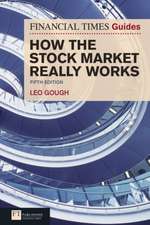The Financial Times Guide to Business Numeracy: How to Check the Figures for Yourself: Financial Times Guides
Autor Leo Goughen Limba Engleză Paperback – 31 ian 2012
Banks and financial institutions, businesses and politicians often spin their statistics as they know they can rely on customers or constituents not to understand or check maths and formulas.
This book introduces you to the basic tools of maths, statistics and business calculations so that that you can understand the numbers, work out your own calculations and make better investing, saving and business decisions.
Preț: 207.45 lei
Nou
39.70€ • 41.29$ • 32.78£
Carte disponibilă
Livrare economică 24 martie-07 aprilie
Livrare express 07-13 martie pentru 30.55 lei
Specificații
ISBN-10: 027374643X
Pagini: 222
Ilustrații: Illustrations
Dimensiuni: 155 x 231 x 18 mm
Greutate: 0.47 kg
Ediția:2nd revised edition.
Editura: FT Press
Seria Financial Times Guides
Textul de pe ultima copertă
"To approach business and financial markets with confidence, you need a basic grasp of statistics. Whether you're a newcomer to stats or just a bit rusty, Leo Gough's excellent bookcovers the key knowledge you'llneed. Not only are his case-studies straightforward to read, they're lively and practical too." "Dominic Picarda, CFA. Associate Editor, Investors Chronicle." "Ever been in a meeting where the 'experts' try to bamboozle and mislead you with statistics, probabilities and financial jargon? This book gives you the ammunition to fight back" "Ian Cornelius, Director, Cashability" " "
In business you can never be too numerate.
The "Financial Times Guide to Business Numeracy" is your definitive guide to mastering numbers. Using real life examples and practical techniques, Leo Gough covers everything from basic calculations to complex decision-making techniques in order to give you the tools to be able to make informed decisions with confidence. This book shows you how to:
- Get to grips with basic finance and investment concepts
- Think critically about data so you spot misleading statements and inflated results
- Apply estimating and forecasting techniques
- Formulate investment choices based on your own analysis
- Choose the best methods for presenting results in order to maximise outcomes









